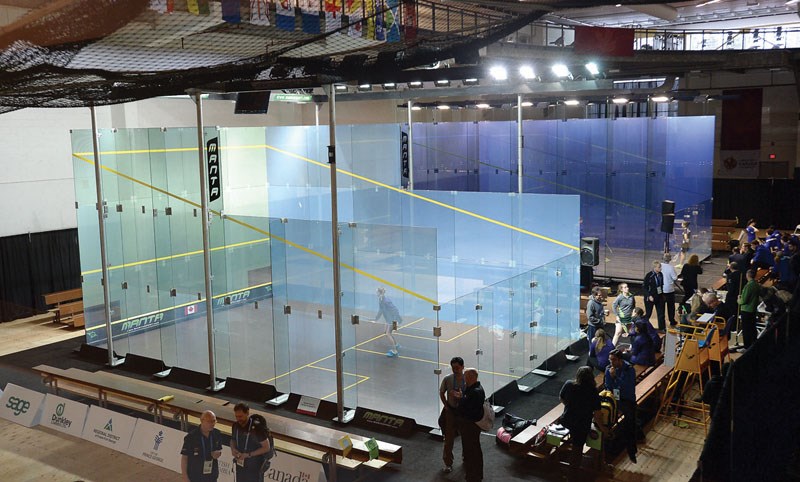Squash has always been a unfriendly spectator sport.
Most squash courts are in club facilities and have solid white walls on three sides and a glass enclosure at one end, which includes the doorway entrance. And once the crowd congregates at that one end to see the matches, the fight for unobstructed viewing positions begins.
That hasn't been a problem at the Canada Winter Games.
The unique setup of two portable courts with Plexiglas walls on all four sides assembled at the Northern Sport Centre fieldhouse has allowed unprecedented views of the action on the courts for spectators, photographers and videographers, who can capture the expressions on the faces of the players as they watch the ball coming at them. There are head-on views of the court from the front and rows of seats set up along the sides of the courts and in the back where the referees sit, and those stands have been full most of the week.
The Games have attracted Canada's best under-19 women and the top under-23 men and the level of play the past few days has been off the charts. Prince George has never seen squash played at such a high calibre and having the excitement of the matches showcased in a state-of-the art facility has left a huge impression on the fans, players, coaches and officials.
The city's only other squash facilities are the two courts located on the second floor of the Northern Sport Centre, which were also used for the Games. Matches played in the two upper courts were shown live on two large video screens adjacent to the glass courts.
The glass courts were installed by a crew from Manta World Sport of Kamloops. Both courts were made in Germany and have been used at several high-profile tournaments in North America. The bluish glass court, in which the gold-medal matches were decided, will be shipped to Toronto this July as one of the four courts to be used for the Pan Am Games. The other court will be sent to Barbados after the Games for an international tournament.
"We helped them assemble this and one of the guys (from Manta) is quite involved in squash worldwide and he thinks there has only been two or three times in the world where there's been two glass courts set up in one spot," said Reg Foot, Canada Winter Games co-sport leader for squash.
The walls are tinted with blue or grey dots and while players can see people outside of the court, their eyes are focused on the ball and everything else becomes a blur. Unlike conventional white-painted courts where a black ball is used, a white ball is used in the glass courts.
"We were itching to play after we got it all set up Saturday and for the first little bit it's weird but after a while you get the hang of it," said Foot.
Sometimes players temporarily lose track of the ball on a high shot because it's a white object passing in front of a white light, but they otherwise gave the glass courts rave reviews.
"This is the first time I've ever played in a glass court and it takes a while to get adjusted to it because when the ball comes near the glass wall it's hard to see and when you look up for lobs and stuff the lights really blind you," said Team B.C. player Nic Vincent of Victoria. "But I really like it more with the stands and the people cheering you. You barely see them when you're playing and it's the best way to show squash."
"I was really nervous at first because I'd never played on glass before but after a couple times I got used to it," said Andrea Toth of Vancouver. "Just the way the ball bounces is different and sometimes when you swing, you get too close or too far. The colour of the ball and the lights is different. But now that I've adapted to it, I like it."
B.C. team coach Benjamin Uliana of Victoria wishes all squash courts were made of glass.
"It's the best thing we could have," he said. "It's a tougher way to play but once you get used to it, spectator-wise it's going to sell the game. Even the pros, when they play professional tournaments, only have one glass court set up. Having two set up side-by-side is unbelievable."
The Prince George Squash Association inquired about keeping one of the glass courts as a possible legacy of the Games but was turned down in its request because the NSC is used for other sports and there is no suitable alternate space for it.
"It would be very nice to have more than two courts, and some viewing space to get people involved in the sport," said CWG squash co-sport leader Barry Hirtz. "We used to have six courts in the city but now we're down to just the two up here and it makes it difficult to run a tournament."



